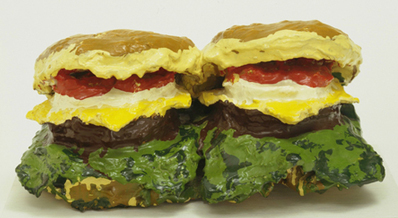Claes Ildenburg's unbuilt folly, the Maus Museum - a civic art gallery - in the shape of Mickey Mouse's head - is a fantasy with serious intent: a symbol, this imaginary institution, of all those collisions between high and low culture that Oldenburg and his generation engineered. If Pop Art was a party, the guests came from all social backgrounds: the Mona Lisa shook hands with Krazy Kat; Michelangelo rubbed shoulders with the Velvet Underground. The Maus Museum - where Vermeers might hang next to Warhol soup cans - would have been the perfect venue.
It would, too, have been a good place to hang Peter Saul's 1985 painting, Donald Duck Descending a Staircase. Saul's parody of Marcel Duchamp's 1912 Nude Descending a Staircase wittily compresses high modernism and cartoon culture into a single, ludicrous image. In questionable taste, maybe, but artists have been flirting with bad taste ever since Braque and Picasso began to paint with Ripolin and stick bits of newspapers to their canvases. Duchamp himself might not have disapproved of Saul's pastiche. ''The worst danger,'' as he once remarked, ''is that one might arrive at a sort of taste''.
The Oldenburg and the Saul are prominently reproduced in ''High & Low'', by Adam Gopnik and Kirk Varnedoe. This is the catalogue to an exhibition now at the Museum of Modern Art in New York but stands on its own as a brilliant account of the vexed relationship between the visual arts and popular culture during the course of this century. It also turns out to be essential reading for anyone interested in art now.
The authors write tellingly of the gap that separates the contemporary artist seeking inspiration in ''low'' culture from his twentieth-century predecessors. While ''the low world outside the studio'' was, ''for over a century,...


